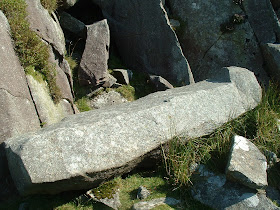
I was encouraged by Barrie Foster's Blog to think again about British icons, British myths and national identity. This is interesting territory, and Stonehenge is right in the middle of it. Think about it. Our sense of "Britishness" is underpinned and supported by a wide range of myths which, taken together, contribute towards our sense of belonging to a community and a nation. Icons and myths abound, and their locations also become important -- King Arthur and Glastonbury and Tintagel, Robin Hood and Sherwood Forest, Henry Tudor and Bosworth Field, Strange Monster and Loch Ness, the Battle of Britain and Kent, William the Conqueror and Hastings, Last Invasion and Fishguard, and so on. Add Clever Neolithic Ancestors and Stonehenge.
Woe betide anybody who seeks to "debunk" any of these, because we WANT to believe them, and if any one of them is debunked, we feel that our sense of belonging, or our sense of national identity, is reduced or devalued. So when I point out -- ever so politely -- that there is actually no evidence for the story of the human transport of the bluestones, the instinctive response is "So what? We want to believe it, so we'll believe it anyway." That's fine for the man or woman in the street (and I'm just as big a Robin Hood fan as the next man) but it's not so fine for those who purport to be scientists and academics. I stand to be corrected here, but it seems to me that academic historians do seem to have a pretty clear idea where history ends and mythology begins -- and indeed they happily do research into mythology and its roots. But prehistoric archaeology seems to have moved so far into the field of fantasy and speculation (maybe because there is no WRITTEN evidence to call upon) that the lines are blurred and even invisible. So they see evidence and proof where there is none, and convince themselves that they are being terribly scientific whenever they get some nice gadgets to play with. Am I being unfair here? You tell me!
--------------------------------------
My post from March 29th, 2010: I have expressed my amazement in earlier posts that he (HH Thomas) "got away with murder" in that NOBODY seems to have seriously examined his evidence or questioned his wacky idea that the stones had been hauled by tribesmen all the way from Presely to Stonehenge in a totally unique feat of Stone Age long-distance transport. And why did people not scrutinize his theory more closely? Why, because there had been great discoveries about megalithic structures in Germany, and because British archaeologists were desperate to show that in these islands we had even more advanced prehistoric civilisations and even cleverer engineers and technicians.
Sounds absurd? I don't think so -- and a number of other authors have suggested that Thomas's idea was carefully put together around the time of the First World War as part of a national "feel good" strategy, and that the whole nation (and not just the archaeologists) just loved the idea when he announced it, and were disinclined to examine it carefully.
So Thomas became famous, then the bluestones became famous, and the "bluestone transport story" entered the mythology of Britain. It is still trotted out ad infinitum, even though there is even less evidence for it now than there was in 1920. And anybody who dares to question it, or to undermine our cosy assumptions about the extraordinary skills of our Neolithic ancestors, is likely to get short shrift from the archaeology establishment. Look at what happened to poor Geoffrey Kellaway......."






















